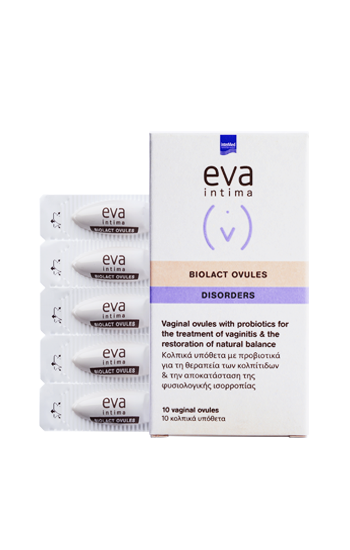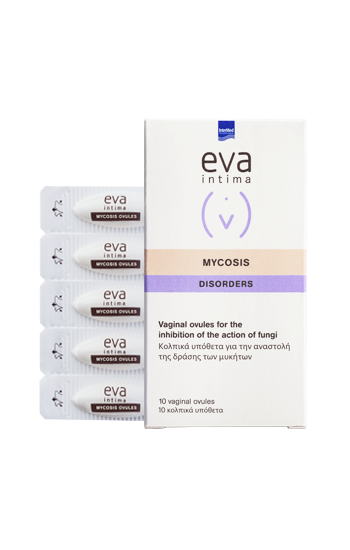





Why is this product suitable?
EVA INTIMA® MYCOSIS OVULES with boric acid, tea tree oil and lactic acid is a medical device specially designed to respond effectively to persistent fungal vaginitis from azole-resistant Candida albicans strains as well as no-albicans Candida strains. Thanks to its enhanced composition, EVA INTIMA® MYCOSIS OVULES balances the vaginal environment, restoring the physiology of the area, and relieving the symptoms of vaginitis due to fungi.

Inhibition of fungal activity 90% in 48 hoursç

Active against all strains Candida sp

With 600mg of boric acid per dose

Easy use morning-evening
How does it work;
Boric acid: Inhibits the activity of Candida fungi by up to 90% within 48 hours.
Lactic acid: Balancing the acidic vaginal environment, enhancing the acidophilic beneficial flora of the vagina and creating an unfavorable environment for the further growth of fungi.
Polycarbophil (PCP): Having increased bio-adhesive action, it maximizes the expected results while at the same time participating in the acid-base balance.
How do I use it?
Apply 1 vaginal suppository a day for 5 to 7 days, ideally before going to bed or on the advice of your gynecologist.
Remove a vaginal suppository with its case from the blister package by tearing in the perforated area. Open the case and remove the vaginal suppository by pulling the two flaps opposite the bottom of the case. Insert the vaginal suppository deep into the vagina using the index finger.
WE ARE HERE to answer you
Each question corresponds to a need. That is why it is worth answering it.
What is vaginitis?
Vaginitis is characterized by inflammation of the vaginal mucosa, i.e. the lining that covers the inner surface of the vagina.
What are the symptoms of vaginitis?
The main symptoms of vaginitis, regardless of its etiology, are the presence of pruritus (itching), irritation, burning and excessive secretions of a different texture, smell and color from the normal ones. Pain during sexual intercourse and urination can often coexist.
What are the most common causes of vaginitis?
The most common causes of vaginitis are bacteria and fungi and can often be caused by a lack of estrogen or allergies (e.g. from the use of condoms or other intravaginal products). However, it is not uncommon for inflammation to occur but without finding a specific cause. These cases are characterized as non-specific vaginitis and are usually attributed to hormonal imbalance (common during pregnancy).
How do I know if I have fungal vaginitis?
Fungal vaginitis is the second most common vaginitis. It is not a sexually transmitted disease and cannot be transmitted as fungi are part of the normal flora of the vagina, where they remain normal in low populations. Common causes of their overgrowth that can lead to vaginitis are conditions that lead to a decrease in lactobacilli in the vagina and the predominance of other microorganisms in the area (e.g. after taking antibiotics for any reason, use of inappropriate and strong antiseptic vaginal solutions, etc.).
Symptoms that are usually predominant are intense pruritus (itching), irritation, burning and the appearance of excessive secretions of viscous texture and white color characterized as leukorrhea, without the presence of a characteristic unpleasant odor.
In any case, the correct and safe diagnosis and treatment is performed only through the gynecologist after a series of diagnostic tests (colposcopy, vaginal discharge culture, etc.), a practice that is recommended to follow every time you notice changes in the wider area.
How can I relieve the symptoms of vaginitis?
Depending on the symptoms that concern you there are product options that can relieve you. However, complete relief from the cause of inflammation can not be achieved without first diagnosing it and receiving appropriate treatment from your gynecologist.
In case of bacterial etiology of vaginitis you can combine (scheme for bacterial vaginitis)
In case of fungal etiology of vaginitis you can combine (scheme for fungal vaginitis)
In case of non-specific etiology of vaginitis you can combine (figure for atypical vaginitis)
How can I prevent the appearance of a vaginitis?
The appearance of a vaginitis can be prevented if the normal flora of the area is maintained with the predominance of lactobacilli, the acidic environment of the vagina (pH 3,5-4,5) in the presence of lactic acid and the necessary moisture for the tissues. Securing these factors prevents the development of infections. In case their presence is disturbed, appropriate product options such as probiotics, vaginal pH regulators and hydrating products can help to restore and maintain them and prevent infections.
Indicatively you can combine (scheme for prevention of vaginitis and enhancement of natural balance)
Tips:
- You can adopt the daily intake of probiotics by mouth through special supplements with lactobacilli to easily and naturally strengthen the flora of the vagina
- You can use daily special cleansing fluids for the sensitive area with enhanced composition for protection against microorganisms.
I often get vaginitis shortly after my period. Why is this happening to me? What can I do?
The transition to reproductive age is marked by the periodic appearance of bleeding that lasts for a few days and usually occurs every 24 to 28 days. The presence of blood in the vaginal area -although normal- can lead to minor disorders in the vaginal environment affecting the vaginal pH and the presence of lactobacilli as the blood has a neutral pH. This effect, combined with the fact that blood is an excellent nutrient medium for fungi normally present in the vagina, often leads to the body's inability to control the overgrowth of fungi that eventually cause inflammation in the area.
Enhancing the normal mechanism of removal of bleeding residues and the immediate restoration of vaginal pH to its normal acidic values can reduce the occurrence of vaginitis after the end of the period.
Indicatively you can combine (scheme for prevention of vaginitis and enhancement of natural balance after period)
Tips:
- Prefer the use of a panty liner with a cotton cover which you change regularly in relation to the tampons
- You can use daily special cleansing fluids for the sensitive area with enhanced composition for protection against microorganisms.
- You can adopt the daily intake of probiotics by mouth through special supplements with lactobacilli to easily and naturally strengthen the flora of the vagina
I often get a recurrence of vaginitis due to fungi. Why is this happening to me? What can I do?
Fungi, although natural colonists of the vagina, very often lead to infections and there are specific reasons that reduce the likelihood of successful reduction and relief from the manifestations of vaginitis. As a result, the recurrence of symptoms of fungal vaginitis is often recorded very soon from the previous episode, which is characterized as a relapse. The main reasons are the development of resistance to the usual medications, the incomplete diagnosis, the self-diagnosis, the non-observance of the treatment regimens, etc.
In any case, the correct and safe diagnosis and treatment is carried out only through the gynecologist after a series of diagnostic tests (colposcopy, vaginal fluid culture, identification of responsible strains, selection of effective active each time, etc.), a practice that is recommended to follow whenever you notice changes in the wider area.
Scrupulous adherence to treatment regimens and the adoption of tactics that directly enhance the local balance and defense of the area are the means to successfully reduce relapses.
Indicatively you can combine (scheme for prevention of vaginitis and enhancement of natural balance)
Tips:
- choose cotton underwear and limit the use of tight synthetic underwear
- avoid the daily use of panty liners
- change your swimsuit immediately and do not sit directly on the sand of the sea
- generally avoid tight clothing and anything that can significantly increase the humidity and temperature of the area
- use daily special cleansing fluids for the sensitive area with enhanced composition for protection against fungi.
The area of my external genitalia presents an intense itching, irritation and burning sensation. What may it be? How can I be relieved?
The external genitalia are the most exposed area of our genital system.
There are many factors in our daily lives that can upset the balance of the area which may be abnormal such as the use of inappropriate cleansing fluids, synthetic underwear, fragranced panty liners, swimwear, heavy sweating, increased temperature. In addition, the onset of these symptoms as a result of infections such as fungal overgrowth should not be considered unlikely.
In any case, the correct and safe diagnosis and treatment is performed only through the gynecologist after a series of diagnostic tests, a practice that is recommended to follow every time you notice changes in the wider area.
Relief of these symptoms regardless of the cause of their appearance can be achieved through eva intima medival which is an anti-itch cream with a natural mode of action specially designed for the relief of the external genitalia. Diagnosing and treating the cause of these symptoms is crucial for definitive relief from these symptoms.
MORE FROM DISORDERS

BAKING SODA DOUCHE pH 9.0
Vaginal douche to remove accumulated secretions [leukorrhea]
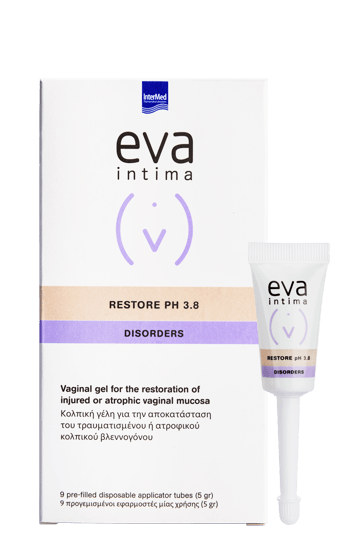
RESTORE GEL pH 3.8
Vaginal gel to repair injured or atrophic vaginal mucosa

RESTORE OVULES
Vaginal pessaries to repair injured or atrophic vaginal mucosa
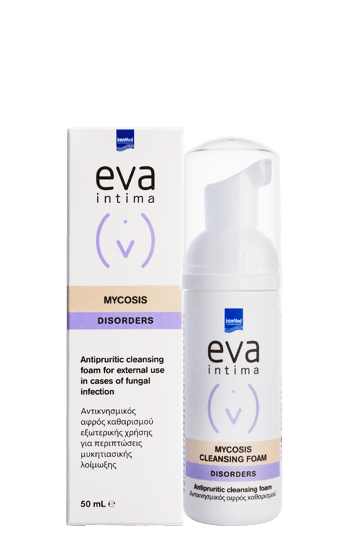
MYCOSIS FOAMING WASH
Antipruritic cleansing foam for external use for cases of fungal infection.
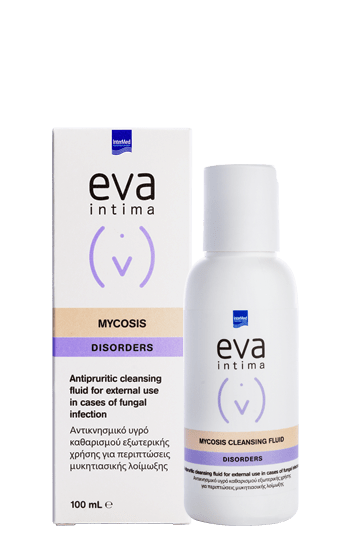
MYCOSIS CLEANSING FLUID
Antipruritic cleaning fluid for external use for cases of fungal infection.

MYCOSIS SPRAY
Spray to inhibit fungal growth
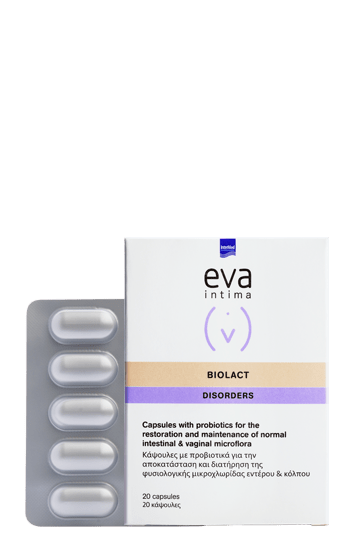
BIOLACT CAPSULES
Capsules with probiotics to restore and maintain the normal intestinal & vaginal microflora
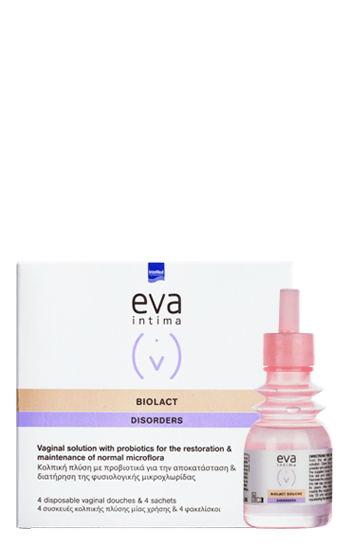
BIOLACT DOUCHE
Vaginal douches with probiotics for the treatment of vaginitis & the restoration of normal balance
